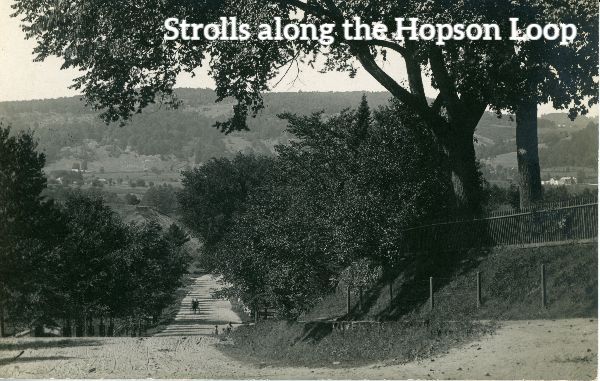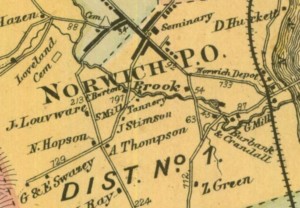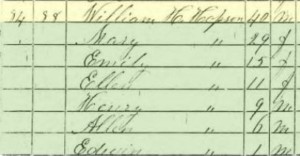
By Lauren Pidgeon
As the weather becomes warmer and the birds begin to sing, more and more people are walking the Hopson Loop. Have you ever been on the loop and wondered about the history of the houses you’re walking past?
Have you ever wondered who the Hopsons were?
Let’s start our stroll with the Hopsons! I started out my research by consulting maps and other documents on the Hopson family.
These two maps below show the farms that were owned by the Hopsons.

This map is from 1856 and shows that N. Hopson and H. Hopson lived across the intersection from each other. You can still see those houses today at the intersection of Hopson and Elm. This map is oriented with Hopson Road running vertically. The big thick lines are the village center.

This 1869 map shows the N. Hopson farm at the intersection of Hopson and Elm. I wonder what happened to the H. Hopson farm. Did they move away? I turned to the Hopson family files in the historical society’s archives and found a small family tree as well as some Civil War letters. I discovered that William H. Hopson and his sons, Allen Hopson and William Henry Hopson, lived in the H. Hopson house. That’s the house located in the southeast corner of the intersection.

This 1850 census shows 40-year-old William H. Hopson living with his children and his wife, Mary. I also found that 48 year old Nelson Hopson was living in the other Hopson house nearby without a family.Both Allen and William Henry went off to fight during the Civil War. Here is an excerpt from a letter that Allen wrote back to his family while he was away.
“I hope we shall get through and go home before too long. I have seen enough of war and enough of fighting too. I don’t suppose anybody cares whether we soldiers ever get back or not. I will be glad when I do get home once more.”
I didn’t find any letters from William Henry Hopson, Allen’s brother, but I did discover a small biography written about him by the historian who put together the letters, presumably someone who knew the family. William Henry was one of the first people in Norwich to register for the Civil War draft on June 1st, 1861 and he was called up a month later.
Between the time the 1856 map of Norwich and the 1869 map were published, William Henry Hopson’s family (who lived in the house currently on the southeast corner of the intersection of Elm Street and Hopson Road) left Hopson Road, leaving just one Hopson family behind. Death records reveal that he died in 1860.
In the following year, William Henry’s sons, Allen and William H., both joined the army to fight in the Civil War.
The Historical Society has a collection of letters written by Allen Hopson and his cousin Edward Sproat. These letters were written while the boys were fighting in Virginia. By the end of 1862, both Allen are Edward write about being cold and tired of fighting:
Allen Hopson
Hagerstown, Md.
October 24th, 1862
It is very cold weather here, and we have no tents of any consequence and not half blankets enough. We can’t get clothes enough; we suffer some. I am thin as a rail.
Edward Sproat
Stafford Court House
November 19th, 1862
We are prepared to fight but we still don’t want one. I have no boots, drawers, gloves, and only one shirt, and that is on my back.
During the Battle of Fredericksburg in Virginia, on December 13th, Edward Sproat was killed and Allen Hopson was wounded. Allen was taken to Washington where he had one of his limbs amputated. He soon died on December 24th, 1862. William H. Hopson, Allen’s brother, was discharged from the army on November 5th, 1862 after struggling with malaria. After regaining his health at home in Norwich, he reenlisted in the military and was fighting again by the spring of 1864. Just a few months later, he died during the Battle of Poplar Springs Church on September 30th, 1864. Two of the Hopson sons had given their life.
William’s Commanding Captain, Lyman E. Knapp wrote a letter to William’s sister informing her of her brother’s death.
Lyman E. Knapp
Capt. Commanding.
Your brother was shot by my side..He was about six feet from me, and the bullets were flying like hail around us when he said to me very calmy : “Captain, I shall bleed to death!” I laid him down and sat beside him while he breathed his last. I was compelled to leave him but my heart remained.
Mary Hopson, their mother, died in 1868, leaving two orphans. Out of the eight children in the family, only three of them survived to adulthood. Nelson Hopson, William Henry’s brother who lived on the neighboring farm, died just months later, in 1869, which meant there were no more Hopsons living on the road.
Many of Norwich’s roads are named after early families. Not only did the Hopsons live on the road but they also farmed much of the area. In 1850, Nelson Hopson owned over 50 acres with 21 sheep and William Henry Hopson owned 6 acres of land.
Next time you come to the crossroads on your walk up Hopson, think about the Hopson boys who fought during the Civil War.
